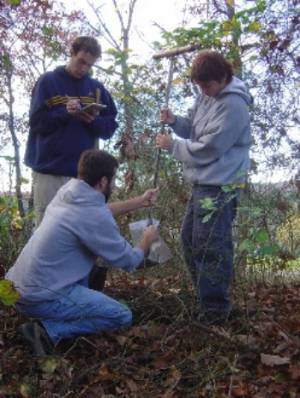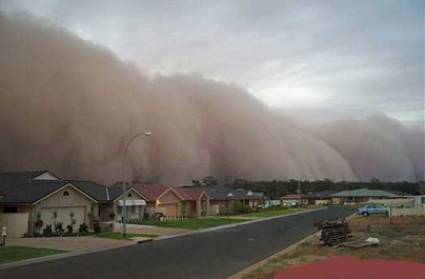Course Requirements
This non-thesis M.S. requires a total of 31 credits.
Of these 31 credits, 30 credits must be courses with the ESS designator or other approved
graduate courses in the fields of astronomy, atmospheric sciences or geology.
A minimum overall grade point average of B is required.
Students are required to complete
ESS 501 Foundations of Earth Science (3 credits) and
ESS 610 Capstone Project (1 credit).

Sampling Soil
www.kutztown.edu/acad/geology/
Capstone Project (ESS 610)
This required capstone project considers unifying themes or "big ideas" such as scale
and structure, models, stability, and change, systems and interactions, energy and
time as they apply to astronomy, atmospheric science and geology. The capstone course
integrates "big ideas" across the earth and space sciences. Students should have taken
at least two undergraduate or graduate courses in each of astronomy, atmospheric science
and geology.
|
|

Dust Storm Griffith, Australia
A scientific research report is required for all ESS classes. The research can be
observational research wherein the students each make their own scientific observations
or collect their own scientific data or it can be a literature review.
Each student will have to do at least one observational research project as part of
the degree requirements.
It is highly recommended that for an observational research project in meteorology
or geology that the area chosen for study be on or near their school campus so that
it can be used as the basis for field trips, outdoor laboratories or research for
earth science students.
For a literature review the instructor may choose a selected topic for study and each
of the students in the class will need to do a literature review on a very narrow
aspect of the scientific topic. This is so students can appreciate the depth of knowledge
in the scientific area.
Each completed report should contain a concise synopsis of the aspect of the topic
written by the student with appropriate figures and tables, a list of references cited
including pertinent links on the Internet. The references cited should mainly include
research reports in journals. Textbooks and the web may be sources for finding appropriate
reports. A rubric for the research paper for each class will be made available by
the instructor.
Lesson plans are not acceptable as a substitute for a research project.
|



